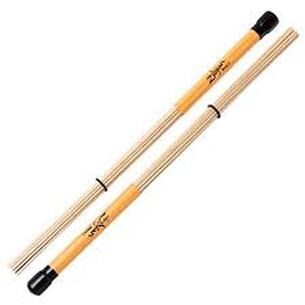Here's a guide to different styles, weights & brands of Drum Sticks. Learn the difference between Brushes, multi rods and Blastix.
Are plastic tip drum sticks better than wooden tip drum sticks? Links to articles and web sites relevant to drum sticks.
Are plastic tip drum sticks better than wooden tip drum sticks? Links to articles and web sites relevant to drum sticks.
1. Wooden Tip Drum Sticks
2. Nylon Tip Drum Sticks
Nylon tip drum sticks refer to the tip or bead of the stick being made of a separate piece of nylon (plastic). This nylon produces a sharper sound on the cymbals and can also prolong the life of the the stick as the tips wont chip- they can however fall off occasionally however.
3. Brushes
|
Brushes are primarily associated with Jazz drumming as they were popular in the Jazz era. They are made of a series of wires (sometimes plastic) joined to a solid handle. By dragging, tapping and flicking the skins and cymbals they produce a truely unique sound.
For an example of Brushes in action check out the master Buddy Rich performing "Brush Strokes" |
4. Synthetic Sticks
|
Drum sticks are produced in other materials apart from wood, including plastics, cardon fibre and even metal. The varying materials will effect the sound, weight and durability of the stick. The best idea when chosing a stick is to try it out. If it doesn't feel good it doesn't matter how durable it is.
|
5. Blastix and Multi Rods
|
These are also known as Hot Rods and other various names but usually refer to a series of small wooden or plastic rods bound into one larger stick. These are great for practice- as they are quieter. But also they produce a unique sound on the drums. A cross between a Stick and a Brush.
|
6. Drum Stick Weights
|
Drum Sticks come in a variety of weights and lengths. There are 4 industry standard weights to choose from; 7A, 5A, 5B, 2B. Basically the higher the number, in the title of a stick, the lighter weight it is. eg. a 7A stick is lighter than a 5A stick. Some brands also make Signature sticks. These are peculiar to the drummer who has designed them. Remember try a stick before you buy it - just 'cause you like Tre Cool's drumming doesn't mean his signature drum stick will suit you.
|
7A 5A 2B
7. Parts of the Drum Stick
|
The tip (or bead) of the stick is the primary point for hitting the drum or cymbal. The Shoulder of the stick is often used for hitting the crash cymbal or for sounding rim shots on the drums. The Shaft of the stick is where we hold the stick. The Butt of the drum stick is sometimes used for clicking on the rim of the snare drum.
|
8. Stick Brands
9. Choosing Drum Sticks
|
On each of the beats of the bar below there are different note values. The different types of notes will sound faster or slower when played next to each other over the even beat of the bar. This is how we can represent rhythms in written music.
On the 1st beat is a Quarter note- this note lasts for one beat. On the 2nd beat are 2 Eighth notes, they last for half a beat so they will sound twice as fast as the Quarter note. On the 3rd beat are 4 Sixteenth notes- they will sound twice as fast as the Eighth notes. On the final beat we return to a single Quarter note. Although the notes change speed because of the different values, the beat remains steady and even: 1, 2, 3, 4. |
10. Useful Links
|
In written drum music the different lines and spaces of the stave tell us which drum or cymbal to play. If a note is on the top line it tells us to play a different drum than if it is on the bottom line. Below is an example of the positions of the different drums and cymbals on a stave. Some composers will use slight variations. Generally speaking the lower or higher on the stave the note is then the lower or higher on the drum kit it is too- bass drum on the bottom line, crash cymbal at the top etc.
|












